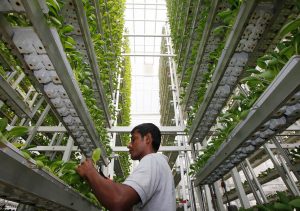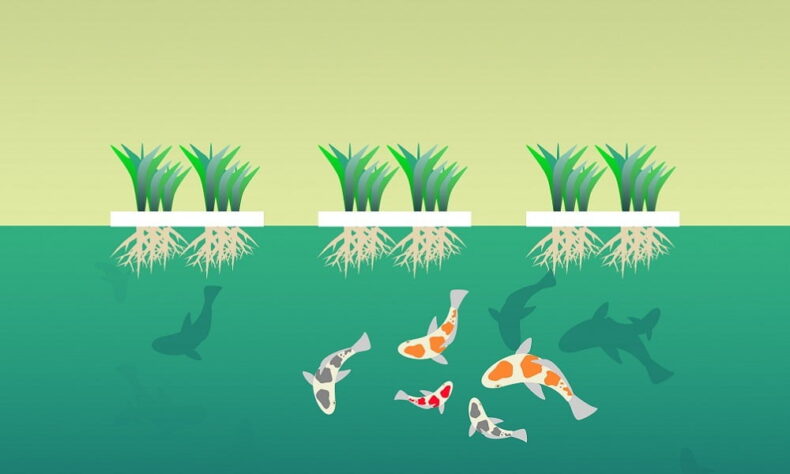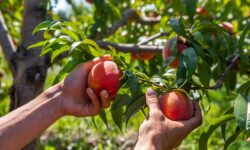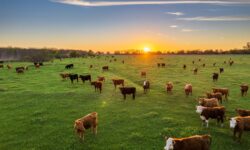Extreme weather throughout the year will cause a shortage of stone fruit in BC: We…
Our food system today is up against many increasing challenges such as water scarcity, soil degradation, and a growing inability to properly distribute food to everyone. And while this is incredibly important to talk about and address, the stories of hope about our food system are often overlooked. This week, we want to change the tone.
From the use of miniature sensors to monitor crop needs, to the elimination of soil as a variable needed to grow food, the future of farming is breaking all sorts of agricultural traditions! Here is your sneak peek at some of the most exciting agricultural practices that may one day become the norm for how our food is made.
-
1. Vertical Farming
With agriculture already a leading cause of deforestation worldwide and with the world population increasing to nine billion by 2050, we need to make better use of space (2). One way this is being addressed is through the introduction of vertical farming. Vertical farming is defined as “…an engineering solution to increase productivity per area by extending plant cultivation into the vertical dimension…” (3). In the future, we may see very localized food as skyscrapers in the city become the modern day “farm”.

-
2. Hydroponics
Often used in vertical farming, hydroponics is a way of growing crops that does not use soil (4). In some cases, plants can be grown in a certain medium, such as sand or gravel, however some produce is grown solely in water containing fertilizers (5). This practice is attractive to some farmers as it is “highly productive [and] conservative of water and land…” however its reliance on advanced technology makes it out of reach for many farmers to adopt (6).
-
3. Aquaponics
Similar to hydroponics, but with a distinct character trait aquaponics is a practice that also grows plants without soil. The difference is, these crops are fertilized specifically by fish waste (7). This agricultural practice actually has an ancient history but it is being revitalized today as the demand for sustainable farming methods increases (8). Not only does this practice reduce agriculture’s reliance on non-renewable resources, which conventional farming practices are highly dependent on, but it also effectively recycles nutrients and water through its “closed-loop” system (9). Although the use of fish waste to grow your lettuce may sound gross, these systems are able to convert what we previously perceived as waste into a valuable and regenerative resource.
-
4. Climate Smart Agriculture
Agriculture and climate change have a unique relationship in that farming is a highly vulnerable industry to climate change, but it is also one of the biggest contributors to it (10). Due to this unique position, climate smart agriculture is method that aims to reduce greenhouse gas emissions that are created by farming practices, while also exploring ways to make farms more resilient to climate change-related impacts (11). For example, some farms are integrating trees into their fields, known as agroforestry. These trees will naturally soak up carbon dioxide, a leading greenhouse gas, while also improving soil’s ability to hold water (12).
-
5. Precision Agriculture
Precision Agriculture uses wireless sensor networks in agriculture (13). This allows agricultural practices and field conditions to be observed, assessed and controlled much more precisely (14). This high-tech form of farming largely benefits farms that are heavily dependent on the use of inputs, like pesticides or fertilizer, as these sensory networks will show farmers exactly where inputs are needed rather than having to use “one-fits-all” strategy (15). This precision will reduce farmer’s expenses on inputs and reduce overall resource use.
Sources:
- 1. Vidgen, Helen Anna, and Danielle Gallegos. “Defining food literacy and its components.” Appetite 76 (2014): 50-59.
- 2. Al-Chalabi, Malek. “Vertical farming: Skyscraper sustainability?.” Sustainable Cities and Society 18 (2015): 74-77.
- Harvey, Celia A., et al. “Climate‐smart landscapes: opportunities and challenges for integrating adaptation and mitigation in tropical agriculture.” Conservation Letters 7.2 (2014): 77-90
- 3. Touliatos, Dionysios, Ian C. Dodd, and Martin McAinsh. “Vertical farming increases lettuce yield per unit area compared to conventional horizontal hydroponics.” Food and energy security 5.3 (2016): 184-191.
- 4. Jensen, Merle H. “Hydroponics.” HortScience 32.6 (1997): 1018-1021
- 5. Ibid.
- 6. Ibid
- 7. Goddek, Simon, et al. “Challenges of sustainable and commercial aquaponics.” Sustainability 7.4 (2015): 4199-4224
- 8. Ibid.
- 9. Ibid.
- 10. Lipper, Leslie, et al. “Climate-smart agriculture for food security.” Nature climate change 4.12 (2014): 1068.
- 11. Harvey, Celia A., et al. “Climate‐smart landscapes: opportunities and challenges for integrating adaptation and mitigation in tropical agriculture.” Conservation Letters 7.2 (2014): 77-90.
- 12. Ibid.
- 13. Baggio, Aline. “Wireless sensor networks in precision agriculture.” ACM Workshop on Real-World Wireless Sensor Networks (REALWSN 2005), Stockholm, Sweden. Vol. 20. 2005.
- 14. Srinivasan, Ancha, ed. Handbook of precision agriculture: principles and applications. CRC press, 2006.
- 15. Ibid.




